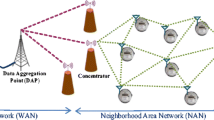Abstract
Smart meters are needed for realizing energy savings and automatic meter reading. As smart meters used for the gas or water supply infrastructure cannot always receive supplied power, a low-power-consumption communication protocol for battery-powered smart meters is required. The U-Bus Air protocol is standardized for gas meters in mid- and high-rise buildings. U-Bus Air has the features of low power consumption using time asynchronous communication and multi-hop communication among nodes. However, the interference power increases as the number of nodes increases. In order to solve the problem, intermittent receiver-driven data transmission media access control (IRDT-MAC) was proposed; it finds the appropriate transmission cycle (intermittent interval); the communication performance is improved using the derivation of the collision probability. On the other hand, IRDT-MAC cannot correspond to a change of link topology. In this paper, we propose a protocol for controlling the receiver beacon transmission interval using the fusion center (FC) for solving the above problem. In this protocol, the link topology of each smart meter is sent to the FC and the FC calculates the suitable transmission cycle for this specific topology. Finally, the suitable transmission cycle is fed back to each node from the FC. Using computer simulations, improvements of the packet delivery ratio (PDR), the throughput, and the power consumption are confirmed in two topologies. Specifically, the improvements are confirmed in the case of two stages or more in the building-wide square topology.


















Similar content being viewed by others
References
Bouhafs F, Mackay M, Merabti M (2014) Communication challenges and solutions in the smart grid. Springer, New York, pp 53–68
Hayashi H (2014) Evolution of next-generation gas metering system in Japan. In: 2014 IEEE MTT-S international microwave symposium (IMS2014), Tampa, FL, pp 1–4
Kojima F, Harada H (2014) Superframe division multi-hop data collection with aggregation on wi-sun profile for echonet lite. In: Wireless communications and networking conference workshops (WCNCW), Istanbul, pp 116–121
Sato T, Kammen D M, Duan B, Macuha M, Zhou Z, Wu J, Tariq M, Asfaw S A (2015) Smart grid standards: specifications, requirements, and technologies. Wiley, Singapore, pp 299–328
Sum C S, Lu L, Zhou M T, Kojima F, Harada H (2015) System evaluation of a practical ieee 802.15.4/4e/4g multi-physical and multi-hop smart utility network. IET Commun 9(5):665–673
Pantoni R P, Brandao D (2015) Receiver initiated transmission strategies applied to street lighting systems based on wireless sensor networks. Int J Wireless Inf Networks 22(2):126–137
Suzawa K, Fujiwara J, Masahiro Y, Fujii Y, Asada A, Yamashita R, Masuda Y, Nishiguchi K, Fukushima K, Ichikawa T (2014) Development of gas smart metering system. In: International gas union research conference (IGRC), Copenhagen
Tsuchiya H (2011) Characterization of the radio propagation channel in residential environment for smart meter communications. In: Asia-pacific microwave conference 2011, Melbourne, pp 713–716
Hayamizu T, Kominami D, Sugano M, Murata M, Hatauchi T (2012) Performance improvement by collision avoidance of control packets in receiver-driven multihop wireless mesh networks. In: 2012 IEEE 9th international conference on mobile ad-hoc and sensor systems (MASS 2012), Las Vegas, Nevada, pp 473–474
Kominami D, Sugano M, Murata M, Hatauchi T (2011) Energy-efficient receiver-driven wireless mesh sensor networks. Sensors 11(1):111–137
Sun Y, Gurewitz O, Johnson D B (2008) Ri-mac: a receiver-initiated asynchronous duty cycle mac protocol for dynamic traffic loads in wireless sensor networks. In: Proceedings of the 4th international conference on embedded networked sensor systems (SenSys 2008), Raleigh, NC, pp 1–14
Buettner M, Yee G V, Anderson E, Han R (2006) X-mac: a short preamble mac protocol for duty-cycled wireless sensor networks. In: Proceedings of the 4th international conference on embedded networked sensor systems (SenSys 2006), pp 307–320
Oller J, Demirkol I, Casademont J, Paradells J, Gamm G U, Reindl L (2016) Has time come to switch from duty-cycled mac protocols to wake-up radio for wireless sensor networks? IEEE/ACM Trans Netw 24(2):674–687
Duan R, Fang D, Chen X (2015) A wakeup adapting traffic and receiver-initiated duty cycle protocol for wsn. In: 2015 IEEE 12th international conference on ubiquitous intelligence and computing and 2015 IEEE 12th international conference on autonomic and trusted computing and 2015 IEEE 15th international conference on scalable computing and communications and its associated workshops (UIC-ATC-ScalCom), pp 1753–1759
Acknowledgements
This work contains the results of joint research with Tokyo Gas Co., Ltd.
Author information
Authors and Affiliations
Corresponding author
Rights and permissions
About this article
Cite this article
Moriyama, T., Nakayama, T. & Fujii, T. Intermittent Interval Feedback Design for Multi-Stage Wireless Sensor Networks. Mobile Netw Appl 22, 970–982 (2017). https://doi.org/10.1007/s11036-017-0859-0
Published:
Issue Date:
DOI: https://doi.org/10.1007/s11036-017-0859-0




